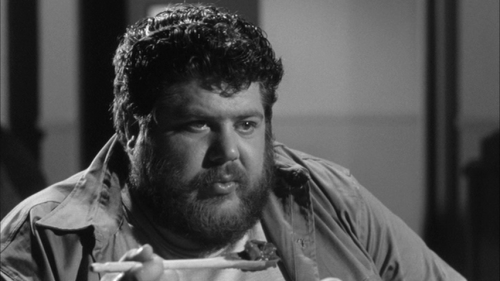This is the fourth of my notes about my ongoing series of films at The Woodmill Studios in Bermondsey. To see the entire line up and get all the details go here.
‘My name is Johnny Barratt. I’m a reporter on the Daily Globe. This is my story, as far as it went.’ So begins Shock Corridor, Samuel Fuller’s 1963 film. Fuller was a newspaper man himself, starting as a cub crime reporter in the 1920s in Boston. That much explains the high-seriousness with which the task of reportage is held in the film: Johnny Barratt is on a self-sacrificing mission for The Truth. The Truth he hopes to uncover is the real story behind the murder of an inmate at a mental institution. Obviously the only thing to do is sham insanity, convincing the authorities he is an incestuous fetishist, and to canvass witnesses in the asylum as a patient. But murder is not the only evil going on in the institution and Johnny finds the mental institution a Mexican finger trap once he is inside.

Fuller was a man who disdained subtlety (‘If your first scene doesn’t give you a hard on, throw the god-damned thing away,’ Fuller once advised his protege Jim Jarmusch). Originally titled The Long Corridor, its immediately apparent that the electro-shock therapy is only half of the title’s ramifications. The confrontational style on display in this film later turned sour against Fuller. Despite a history of support for the civil rights movement, his lack of equivocation in his portrayal of racism in White Dog barred him from the studio system for the latter portion of his life. It was only in his twilight years that a new generation of filmmakers – Tarantino, Jarmusch and cinema’s greatest defender Martin Scorsese – recognising the same commercially successful but direct and controversial mode of filmmaking, sought to draw him in from the wilderness.
Shock Corridor was made outside the major studio system, which lends it both its enduring merits and distinct faults. The film shows prescience about the then-bubbling countercultural anti-psychiatry movement. By 1975, One Flew Over the Cuckoo’s Nest was an Oscar-sweeping smash. Forman’s film uses the same narrative strategy as Shock Corridor: use an ostensibly sane man to highlight the brutalising effects of mental health ‘treatment’, at the same time using the mental institution as a heightened microcosm of the insanity of conformist society. The rage of Forman’s film is evident over a decade earlier in this film, at a time when A Child is Waiting – John Cassavetes’ manipulative and tasteful take on a child’s mental institution – was Hollywood’s idea of hard hitting, socially conscienced filmmaking.
Barratt’s investigation of the three witnesses of the murder of Sloane gives Fuller the opportunity to unveil three casualties of the schism in American culture of the time. The repeated question of Pagliacci – ‘What are you in for Barratt?’ – hints at the ‘undiagnosed madness’ of ostensibly ‘sane’ society. All of madnesses suggest that the mental institution is a gallery of sinners not unlike The Divine Comedy, with punishments becoming a brutally ironic take on the ‘crime’. Stuart, a soldier vilified for his communist sympathies, is forced to endlessly relive the divided America of the Civil War. Trent, having cracked under the vilification of being the only black student at a Southern university, becomes his arch-nemesis: the Klu Klux Klansman. The overreaching intelligence that allowed Dr Boden to create the atom bomb now consigns him to a state of the infancy (perhaps an echo of Omar Bradley’s barb of living in an age of ‘nuclear giants and ethical infants’?) Would Fuller have been able to make so unpatriotic an attack on the all pervasive paranoia of American life if this had been a studio picture? Certainly it would be many years before the studios felt comfortable enough in the saleability of this message before they would handle it themselves.
Fuller’s film does however suffer from a lack of the smooth narrative that gives a Hollywood picture its easy digestibility. The portraits of the inmates dominate the film in a way that throws undue stress on them. In these depictions, one is reminded of Foucault’s notion of the difficulty of capturing the nature of madness: there is something too stagey about the performances, too neatly drawn. Recently watching Paul Thomas Anderson’s The Master, I was struck by how close Joaquin Phoenix had come to capturing the unpredictability, the uncertain emotional affect, the volatility that can make mental disorder a troubling presence.
Like Hitchcock’s Spellbound, Shock Corridor’s probing of insanity suggests that a man’s mind is just another MacGuffin: a puzzle that can be finally ‘solved’. Each witness that Barratt attempts to receive testimony from eventually surfaces into lucidity. To highlight this psychological shift, these scenes are shot in subjective colour and prove to be one of the film’s most memorable visual decisions (Fuller recycled footage from his aborted Amazonian film Tigrero for Trent’s surrealistic hallucinations). Yet this binary – colour/black and white; sanity/insanity – is at the heart of why the film seems dated today. Fuller’s Manichean view of the universe and its inhabitants might well be a corollary of his time in the newspaper business: ‘I learned early it’s not the headline that counts but how hard you shout it,’ he said of his narrative apprenticeship. If Shock Corridor seems loudly shouted, it is only the brutal shouting of a pioneer like Fuller that other filmmakers could whisper of shades of grey.








